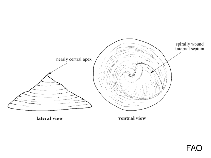Crepipatella dilatata (Lamarck, 1822)
SlippersnailWarning: DOMDocument::load(): SSL operation failed with code 1. OpenSSL Error messages: error:140770FC:SSL routines:SSL23_GET_SERVER_HELLO:unknown protocol in C:\Apache24\htdocs\includes\SpeciesSummary.lib.php on line 1236
Warning: DOMDocument::load(): Failed to enable crypto in C:\Apache24\htdocs\includes\SpeciesSummary.lib.php on line 1236
Warning: DOMDocument::load(https://sealifebase.nrm.se/webservice/AquaMaps/getAMap.php?genus=Crepipatella&species=dilatata): failed to open stream: operation failed in C:\Apache24\htdocs\includes\SpeciesSummary.lib.php on line 1236
Warning: DOMDocument::load(): I/O warning : failed to load external entity "https://sealifebase.nrm.se/webservice/AquaMaps/getAMap.php?genus=Crepipatella&species=dilatata" in C:\Apache24\htdocs\includes\SpeciesSummary.lib.php on line 1236
Upload your photos
Google image | No image available for this species;
drawing shows typical species in Calyptraeidae.
Google image | No image available for this species;
drawing shows typical species in Calyptraeidae.
Classification / Names Common names | Synonyms | CoL | ITIS | WoRMS
Gastropoda | Littorinimorpha | Calyptraeidae
Environment: milieu / climate zone / depth range / distribution range Ecology
Sessile; depth range 0 - 66 m (Ref. 83435). Temperate; 35°S - 56°S, 74°E - 56°E (Ref. 83435)
Distribution Countries | FAO areas | Ecosystems | Occurrences | Introductions
Southeast Pacific and Southwest Atlantic.
Length at first maturity / Size / Weight / Age
Maturity: Lm ? range ? - ? cm Max length : 6.0 cm DL male/unsexed; (Ref. 83435)
It is found on rocky substrates where it is attached to boulders, cobbles, pebbles, and epibiotic on bivalves, Aulacomya atra and the barnacle Austromegabalanus psittacus (Ref. 87801), and in forests of Macrocystis pyrifera (Ref. 92889).
Life cycle and mating behavior Maturity | Reproduction | Spawning | Eggs | Fecundity | Larvae
This is a hermaphrotic species. Egg masses are composed of 29 egg capsules, each one containing up to 721 eggs, and are retained beneath the female shell. Only a few of the eggs develop and the others serve as nutritional eggs (Ref. 87801). It displays poecilogonony as its reproductive strategy (Ref. 99837).
Main reference
References | Coordinator | Collaborators
Rosenberg, G. 2009. (Ref. 83435)
IUCN Red List Status (Ref. 130435)
CITES status (Ref. 108899)
Not Evaluated
CMS (Ref. 116361)
Not Evaluated
Threat to humans
Human uses
| FishSource |
Tools
More information
Age/Size
Growth
Length-weight
Length-length
Morphology
Larvae
Abundance
Growth
Length-weight
Length-length
Morphology
Larvae
Abundance
Internet sources
BHL | BOLD Systems | CISTI | DiscoverLife | FAO(Publication : search) | Fishipedia | GenBank (genome, nucleotide) | GloBI | Gomexsi | Google Books | Google Scholar | Google | PubMed | Tree of Life | Wikipedia (Go, Search) | Zoological Record
Estimates based on models
Preferred temperature
(Ref. 115969): 7.2 - 16.1, mean 10.6 (based on 184 cells).
Price category
(Ref. 80766):
Unknown.



